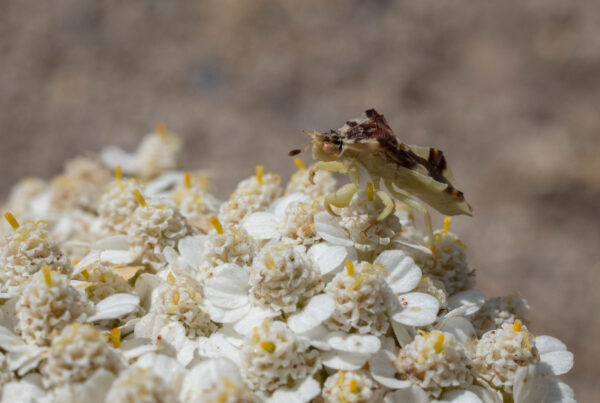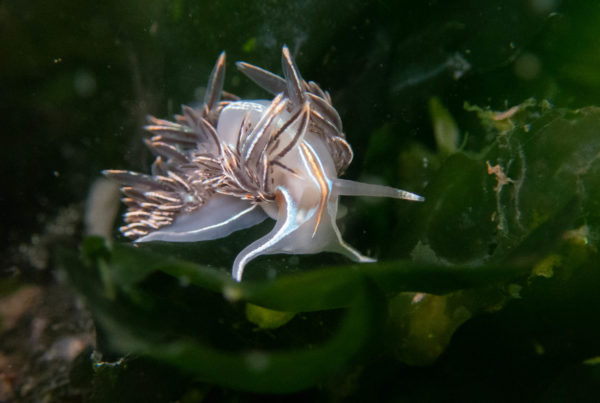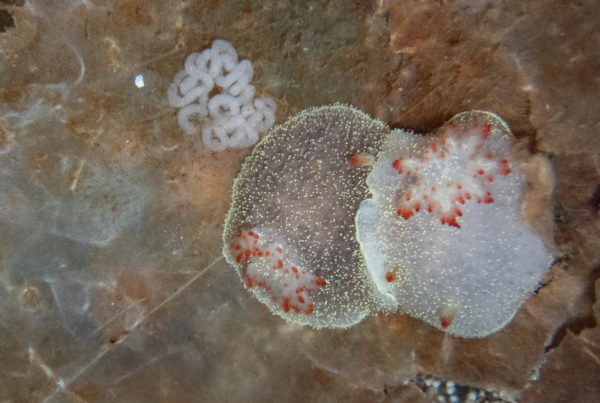Pillar Point in Half Moon Bay is something of a holy grail for nudibranchs. For years I have watched friends on Twitter share their images of the many wonderful nudibranchs they have found at Pillar Point and I longed to visit. Over a year ago, I began making plans to take a trip south. Then the pandemic hit. My grand nudibranch adventure was put on hold indefinitely.
Once I was fully vaccinated, I revisited my original plans and finally made the pilgrimage to California. To be extra safe, I drove and camped which allowed me to stop at Cape Arago in Oregon near Coos Bay to visit low tides on the way down. In an early morning low tide there, I found dozens of huge gumboot chitons all over the tidepools, but only a single, hard to reach nudibranch. Two days later I was ready for low tide at Pillar Point.
I met two Twitter friends and we were greeted by the moon when we arrived at Pillar Point well before the sun rose on the first day. But the tide was already out, so we slid over the seaweed to the fabled nudibranch pools and it didn’t take long to find our first nudis. For whatever reason, there is a cluster of particular pools where local nudibranch hunters know to search for nudis and I was lucky to have one of those hunters show me. It was an absolute joy to finally see in person many of the nudibranchs I had only seen photos of. It was astonishing how easy they were to find. Most were simply crawling on seaweed in the pools and all we had to do was squat down and look. Many of the species like Doto sp. were tiny and hard to spot, but others were larger and easy to see. Some were brightly colored making them easy to see despite being small. And with several pair of eyes all looking for nudibranchs, we found a lot.
Over the two mornings I was lucky enough to see twenty five different species of nudibranchs. A few, like the Stubby Dendronotus were very common and I saw many individuals while others, like the Olive Aeolid were far less common. The number of species were overwhelming and it took me quite a while to learn them. On a good day in Seattle I might see five different species and a dozen or so individuals, but they are really hard to find and require a lot of work digging around in seaweed and flipping rocks. Compared to that, the nudibranch pools at Pillar Point were absolute bliss to find nudibranchs in.
It was definitely worth the nearly two thousand mile, almost week long trip.
Here are all the nudibranchs I saw, save the Janna’s Dorid (Adalaria jannae) which I couldn’t get a decent photo of because it was tucked into a hole in a rock. The final tally was an astonishing 25 species over two days.

Hilton’s Aeolids are one of the larger nudibranchs (up to 50mm) I saw at Pillar Point and fairly abundant. Their dark cerata with orange tips paired with their large size made them pretty easy to spot. This is definitely one of the more photogenic species there and one that is not found in Seattle where I typically search for nudibranchs.

This nudibranch looked familiar to me, but I later learned it’s a different species from what I’m familiar with. But it wasn’t always so. Our Pacific Northwest Shaggy Mouse and the Shag Rug of Pillar Point used to be the same species, but they were recently split. Now the Shaggy Mouse is Aeolidia papillosa and the Shag Rug is A. loui. I found the Shag Rug nudibranchs to be quite pink and although our Shaggy Mouse nudis do vary in color and can be pink, the individuals I see are mostly brown or white. I also learned how to tell them apart, since their range does overlap a little. The Shaggy Mouse (Aeolidia papillosa) has smooth rhinophores while the Shag Rug (A. loui) has warty rhinophores.

Another case of mistaken identity, this nudibranch looks very much like another I regularly see in Seattle, and like the Shaggy Mouse, it was also the same species until recently. In Seattle we have the Leopard Dorid (Diaulula odonoghuei) which used to be the same species I saw in Pillar Point (Diaulula sandiegensis) known as the San Diego Dorid. Their ranges also overlap so it’s good to know the difference. The Leopard Dorid has spots which go all the way to the mantle edges while the San Diego Dorid’s spots stay away from the edges.

This unique nudibranch is nothing like I’d seen before, even though it can be found in the Pacific Northwest. In fact it can be found up and down the entire west coast from Alaska south to Baja California. It is a species I’ve seen in my guide and long wanted to see, so it was a joy to finally see it in person. They are such incredible nudibranchs, almost too strange to be real.

Similar to the previous nudibranch, the Clown Triopha is notable for the white body and orange highlights. It also ranges from Alaska all the way down the west coast. It can also be found across the Pacific in Japan. This nudibranch grows up to 70mm in size, but the individuals I saw at Pillar Point were pretty small. I really liked seeing their frontal veil, which looks like a fancy beard.

Another Triopha, this species is small, but thanks to the bright orange color, easy to see amongst the dark seaweeds. But they’re not always bright orange. The species can vary from brown to yellow and red, but all have light spots on their body. The Spotted Triopha ranges up and down the west coast from Vancouver Island down through Mexico.

Naming this nudibranch “modest” because of its “modest” or “non-descript” colors is an insult. Subtle it may be compared to other, more colorful nudis, but a better name for this nudibranch might be ‘Star Cadlina’ because it looks like stars are embedded into this sea slug. The body is light yellow, almost white to darker yellow with a series of bright yellow spots line their sides like a constellation. It’s found up and down the west coast of North America.

This is the famed relative of our very common Thick-horned Nudibranch of the Pacific Northwest. Like several of the previous nudis, this was once the same species we have in the Pacific Northwest, but was recently split. Now the species found in California is Hermissenda opalescens while ours up here is still H. crassicornis. They look very similar with only subtle differences, but the individuals I saw at Pillar Point were considerably larger than most of the Thick-horned nudis I see in Seattle. They practically glow under the water when lit up with a flash and are a particularly photogenic species.

A familiar species in Seattle, this was a rare discovery at Pillar Point where they are significantly less common than the Opalescent Nudibranchs.

Some of the nudibranchs of Pillar Point were nothing short of show-stopping and the White Dendronotus definitely ranked among those. One of the larger species, they were easy to spot because of their bright white color. Looking at them more closely revealed their spiny looking cerata which are tipped with bright orange. Also found along the west coast, but again one I hadn’t encountered before.

Not quite a show-stopping at the White Dendronotus, the Stubby Dendro made up for it with numbers. These were by far the most common nudibranch at Pillar Point the two days I was there. It was hard to look without seeing one. But they were tricky because while most were brown, some varied towards orange and a few towards white. Many had yellow speckles along their bodies as well.

Nowhere in my reference books can I find Dendronotus venustus. There is a Branched Dendronotus, but it’s listed at Dendronotus frondosus. Why the confusion? It turns out the Branched Dendro of the Pacific, is an entirely different species from the Branched Dendro of the Atlantic. So while all my references and guides to Pacific nudibranchs list the species as D. frondosus, they are all wrong. We only have D. venustus here on the West Coast. Similar in appearance to the Stubby Dendro, their gills are more elaborate.

Most of the nudibranchs I saw at Pillar Point were fairly small, but then there were those that were really small and I did my best to get to know them. This one I only saw two individuals of, but it was pretty distinct and aptly named for the three, white lines that run down the length of their body. It’s another that ranges up and down the west coast, but not one I’ve encountered in Puget Sound before.

Another tiny nudibranch, this one was fairly common, if not always easy to find. The max out at no more than 8mm long.

This species is not one I can find in Washington, their range goes no further north than Oregon. They are also fairly small, up to 14mm long, but their bright colors make them easy to spot among the seaweeds.

A dainty, pretty species, and another small one, I only saw a few of these at Pillar Point.

Despite being the smallest nudibranch I saw at Pillar Point, I saw quite a lot of them. Although they can reach up to 14mm, most of the Dotos I saw were about the size of a grain of rice. They were so tiny it was hard to get a sense for what they actually looked like. Until I found two large individuals. They were so big it was finally easy to see their anatomy.

Almost identical to the Hammerhead Doto, this tiny British Columbia Doto is distinguishable by the brown and yellow pigmentation on their bodies.

Entirely red, this aptly named nudibranch has no markings, but it does have fairly unique rhinophores. I only saw two of these at Pillar Point, not surprising considering they are also small.

Another nudibranch I only saw a couple of, this pretty species has orange cerata with very dark orange rhinophores. This larger species – up to 22mm, is only found from California south and feeds on sea anemones.

Another dainty, and uncommon species – I only saw two – the Rose-pink Cuthona is rather nondescript with muted colors. They can grow up to 18mm, but the individuals I saw were pretty small.

A familiar species to the Pacific Northwest, I saw a few Sea Lemons, but it was hard to identify them at first glance because there were more than one species of large, yellow nudibranchs. These are distinguishable by their white gills and the dark spots on the main part of the body, not on the tubercles. The Sea Lemons were some of the largest species I saw at Pillar Point, and are usually the largest I see in Seattle as well. They can reach 200mm in size, but are generally closer to 50mm.

The twin of the Sea Lemon, the Monterey Doris is not even in the same genus, but looks so similar it takes a close look to tell them apart. Their gills are yellow and their dark spots are generally on the tubercles, not only on the body.

I didn’t even know I had seen a third species of large yellow nudibranchs until I got home. This nudibranch crawling on a leather star was so similar to the other two I didn’t realize it was different. Health’s Dorid is from yet another genus and has small spots and the key point for identification is the dark cluster just in front of the gills.
The final species I saw was Janna’s Dorid (Adalaria jannae), a small, orange nudibranch that was wedged so well into a tiny hole in a rock that I couldn’t get a decent photo of it.
I was inspired to write a haiku about the nudibranchs I saw.







